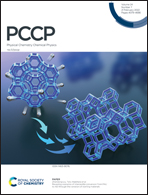From fundamental to CO2 and COCl2 gas sensing properties of pristine and defective Si2BN monolayers†
Abstract
In this work, the capability of Si2BN monolayers (Si2BN-MLs) to sense CO2 and COCl2 molecules was investigated by analyzing the structural, electronic, mechanical and gas sensing properties of defect-free and defective Si2BN-ML structures. Electronic property analysis revealed that the Si2BN-ML retains its metallicity in the presence of vacancy defects. The computed vacancy formation energies of Si, B and N monovacancies are 3.25 eV, 2.27 eV and 2.55 eV, respectively, which indicate that the B monovacancy is thermodynamically more feasible. Besides, both pristine and defective Si2BN-ML structures show good mechanical stability. To validate the gas sensing properties, the adsorption energy and charge transfer were analysed, showing that both pristine and defective Si2BN-ML structures receive considerable charges from the CO2 and COCl2 molecules via a stable physisorption process. The work function analysis revealed that a minute increase <0.10 eV is responsible for the enhanced selectivity and sensitivity of Si2BN-ML structures in detecting CO2 and COCl2 molecules. The low adsorption energies of both CO2 and COCl2 gas molecules during the interaction with Si2BN-ML structures signify the possibility of a large number of adsorption–desorption cycles with an ultra-low recovery time, 0.174 ns for CO2 and 0.016 ns for COCl2, suitable for efficient gas sensing applications.



 Please wait while we load your content...
Please wait while we load your content...